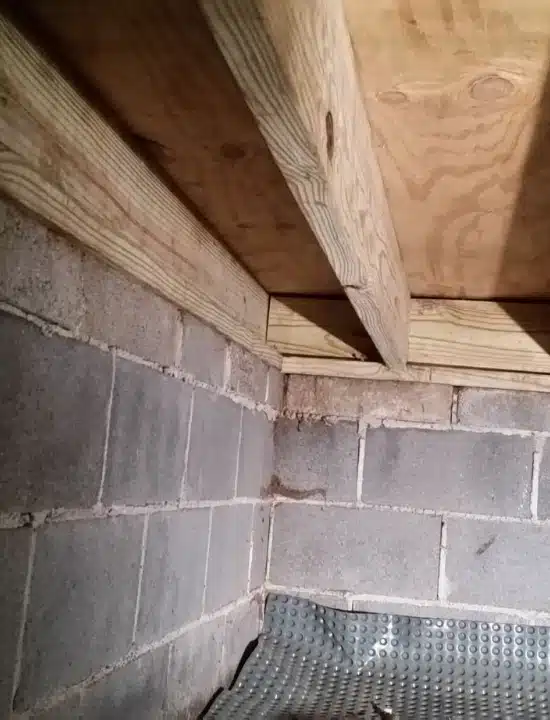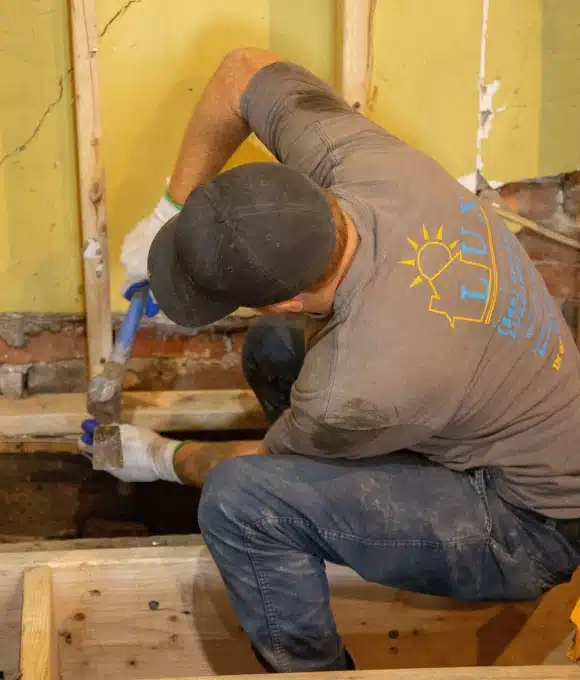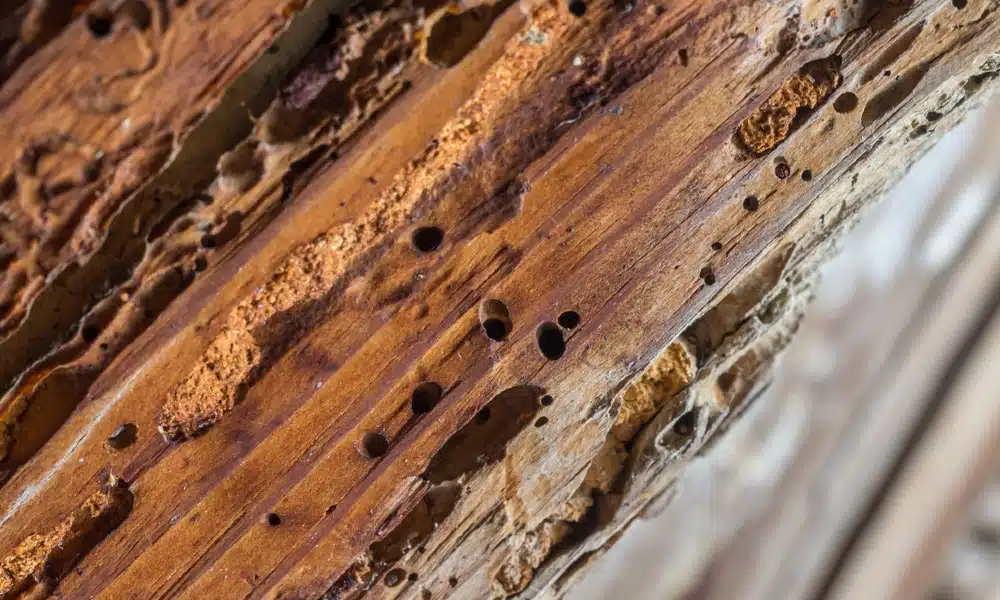Sistering Floor Joists Repair
Fortifying Your Home’s Crawl Space Foundation
Reinforcing damaged joists to strengthen your flooring system above your crawl space, ensuring stability for a secure home foundation with sistering floor joists.
What Is Sistering Floor Joists?

When your floor joists start to fail, reinforcing them before the damage worsens is often the most effective solution. One of the best ways to do this is through a method called sistering.
Sistering floor joists is a process wherein a new joist, or “sister” (a piece of lumber), is attached alongside an existing, often damaged or deteriorating, joist to increase its strength. The ‘sister’ can be as long as the original joist or run alongside the area that needs reinforcement.
This restores the stability of the sagging floor joist without replacing the entire joist, making it a cost-effective and less disruptive solution in the long run. It also helps distribute the load evenly throughout the structure, reducing stress on the existing joists and ensuring they’re capable of supporting the weight of your home for years to come.
Reasons Why Floor Joists Get Damaged
Floor joists can get damaged due to various factors. Here are some common causes:
- Crawl space moisture
- Water damage
- Termite infestations
- Weak soil
- Excessive load
- Mold
- Unencapsulated crawl space
- Foundation Settling
Signs Your Crawl Space Needs Sistering Floor Joists
Understanding the signs of damage can help you address the issue before it escalates. Here are some indicators that your crawl space might need sistering floor joists:
- Sinking or uneven floors
- High indoor humidity levels
- Standing water in the crawl space
- Creaking or squeaking noises when you walk by
- Musty smells in your home
- Doors and windows don’t open and close correctly
- Cracks in the walls or ceilings
- There’s mold on your crawl space’s baseboards or floor above
- Presence of moisture or pests in the crawl space
If you notice any of these signs, it’s advisable to seek professional help immediately.
Why is Sistering Floor Joists Necessary?
Maintaining the health of your floor joists is crucial for your home’s overall structure and safety. Sistering addresses issues like sagging floors or deteriorating joists. In many homes, an unstable floor can result from joists spanning too wide, being spaced too far apart, or failing.
Adding a sister joist in these cases can fix the problem and stabilize the floor. Reasons for sistering joists include:
- Restores strength to weakened or damaged joists
- Levels the floor and minimizes sagging joists
- It mitigates the risk of structural collapse.
- Enhances the value of your property
- Enhances home stability and safety
- Extends the lifespan of your home's structure
- Prevent expensive and extensive repairs down the line.
How to Sister Floor Joists in Crawl Space?
LUX sistering floor joist repair follows a thorough and meticulous process, assuring the highest quality of work and providing a long-lasting solution to your joists’ problems. Using engineered tools and techniques, here are the steps involved in our installation process:
1. Assessing Floor Joist Condition
We begin with a detailed assessment of the condition of your floor joists. We inspect each joist for indications of damage, such as cracks, rot, or deformities. This step helps us understand the damage’s extent and determines the necessity and intensity of the floor joist sistering process.
2. Finding the Root Cause of the Damaged Joist and Offering Solutions to Mitigate
We don’t just fix the issue—we find the root cause. Once we’ve assessed the condition of your joists, the next step is finding out what’s causing your joist to be damaged. This could be due to moisture, pests, or an excessive load, among other factors. Identifying the root cause is vital as it helps us to address the underlying issue, preventing further damage in the future.
After identifying the root cause, we suggest appropriate crawl space repair solutions to mitigate the problem.
3. Removing Wiring and Other Obstructions (Optional)
We may need to remove any wiring, plumbing, or other potential obstructions around the joist area. This ensures a smooth installation process and helps us properly fit and secure the new joist. However, this step may not be necessary if the obstructions do not interfere with the joist installation.
4. Choosing the Right Size of Lumber or Wood and Cutting New Joist
Choosing the right size of lumber or wood is important to ensure a proper fit for the new ‘sister’ joist. We measure the existing joist and cut the new joist to match these measurements, ensuring it will provide the needed support and stability.
5. Using Temporary Jacks During Installation (optional)
If the floor is severely sagging and requires lifting before installing a new joist, temporary jacks are employed during the sistering process. These jacks provide the necessary support to maintain the floor level, preventing additional sagging or shifting while installing the sister joist. However, if the floor is not significantly damaged, there is no need to use temporary jacks during the repairs.
6. Fitting the Sistered Joist
After the new joist is cut to size and the temporary jacks are installed, we fit it next to the existing one. This process, known as ‘sistering,’ allows the new joist to share the load and provide additional strength and support. Our experts ensure this step is done with precision to guarantee the new joist aligns perfectly with the old one and can take on its share of the load.
7. Fastening the Sister Joist
Once the new joist is fit, we fasten the sistered joist using high-quality nails or bolts to secure the new joist in place. This step ensures that the new joist remains firmly attached and can perform its function effectively.
8. Reinstall Utilities (Optional)
After the joist is securely fastened, we go ahead and reinstall any utilities that have been removed for the installation process. We carefully reinstall any wiring or other removed elements, ensuring everything is returned correctly. This step is performed only when necessary and ensures your house remains fully functional post-repair.
Let's Work Together
Why Choose LUX Crawl Crawl Space Sistering Floor Joist?
Choosing LUX for your crawl space joist sistering guarantees top-quality service and optimal outcomes. Our methods are not just about fixing the problem; we aim to provide a comprehensive solution to ensure your home’s longevity and enhanced structural integrity. Here are key features of our crawl space sistering floor joist repair:
- Expert installation by trained professionals
- Usage of high-quality materials for optimal results
- Customized services to cater to individual needs
- Competitive Pricing
- Quick and efficient service execution
- Free Estimate
- Comprehensive Inspection

Secure Your Home with LUX Crawl Sistering Floor Joist Repair
Time is of the essence when it comes to strengthening your home’s foundation. Damaged floor joists won’t repair themselves – they need repairs from the experts.
Don’t let a weakened floor joist compromise the safety and value of your home. Whether it’s sagging, deteriorating, making creaking noises, or other signs of damaged floor joists, LUX Foundation Solutions is always ready to assist.
Contact us at 540-508-8587 or fill out the online estimate form, and our expert team will be more than happy to evaluate your situation and provide a comprehensive solution to all your crawl space repair needs.
We serve Crawl space floor joist repair in Northern Virginia, West Virginia, North Central Virginia, Shenandoah Valley, and surrounding areas. Secure your home’s future with LUX – your trusted partner in crawlspace repair solutions.
Request a free Estimate
FAQ's
Sistering floor joists is necessary when existing ones are weakened, sagging, or show signs of structural compromise. This proactive approach is crucial when the existing joists may no longer meet the required safety and performance standards, providing a durable solution to address structural concerns.
It’s a crucial solution to prevent further deterioration and ensure the stability and safety of your home’s foundation.
Identifying the need for sistering floor joists involves inspecting for signs of sagging, noticeable deflection, or uneven floors. Look for visible foundation cracks, particularly in older homes, and pay attention to any areas where they feel bouncy or unstable.
If you notice these issues, it’s advisable to consult with a professional to assess the structural integrity of your floor system and determine if sistering is necessary to reinforce and strengthen the joists.
Yes, it can significantly improve the overall stability of your home. By reinforcing weakened or compromised joists with additional support, sistering enhances the load-bearing capacity of the floor system, reducing issues such as sagging and uneven floors.
This method effectively strengthens the structural integrity of your home, providing a stable foundation and contributing to a more durable and secure living environment. If you’re experiencing signs of joist issues, considering sistering as a proactive measure can help ensure your home’s long-term stability and safety.
Yes, there are several important structural considerations when sistering floor joists. It’s crucial to ensure that the new joists are the same size and type as the existing ones to maintain uniformity and proper load distribution. Additionally, proper fastening techniques, such as using appropriate nails or bolts, are essential for a secure connection between the existing and sistered joists. Adequate support, including using temporary jacks during installation, is necessary to prevent further sagging or shifting.
At LUX, our expertise ensures a thorough understanding of these structural considerations, providing a professional touch to the sistering process and assuring that it is done correctly and safely, effectively addressing your home’s structural concerns.
DIY floor joist sistering poses potential risks and challenges, primarily related to the lack of professional expertise.
- Inaccurate measurement or improper alignment of the sistered joists may lead to uneven floors or compromised structural integrity.
- Using incorrect fastening methods or inadequate support during installation can result in safety hazards and further damage.
- Additionally, without a thorough understanding of building codes and structural considerations, there’s a risk of non-compliance, potentially affecting your home’s long-term stability.
To mitigate these challenges, consult with the LUX team to ensure a safe and effective process with expert guidance and experience.
Yes, there are preventive measures to avoid floor joist damage in the future.
- Regular inspections of your home’s foundation and floors can help identify early signs of issues.
- Maintain proper ventilation in crawl spaces to prevent moisture buildup, as excessive dampness can weaken joists over time.
- Address plumbing leaks promptly to avoid water damage.
- Ensure proper grading around your home to divert water away from the foundation.
- Avoid overloading floors with excessive weight.
- Ensure that any modifications to the structure are done in accordance with building codes.
Taking these proactive steps can help prevent potential damage and maintain the structural integrity of your home.
Sistering floor joists typically do not affect the functionality of utilities or plumbing, provided the process is executed with precision and consideration. Professionals take care to work around existing plumbing and utilities, ensuring they remain accessible and undisturbed.
However, it’s crucial to hire experienced contractors at LUX who understand the intricacies of the process to minimize any potential impact on utilities. Proper planning and precise execution of the sistering process can maintain the functionality of utilities and plumbing while enhancing the structural integrity of the floor system.
The need for a building permit for sister floor joists varies based on local building codes and regulations. Before undertaking any floor joist sistering project, it is advisable to check with your local building department to determine your area’s specific permit requirements.
Consulting with LUX professionals who are familiar with local regulations can help you navigate the permitting process and ensure that your floor joist sistering project meets all the necessary requirements.
Yes, it can improve the resale value of your home. By addressing and enhancing the structural integrity of your property, potential buyers may perceive it as a well-maintained and sturdy home, which can positively influence their decision-making process.
A solid foundation and structurally sound floors enhance a house’s overall appeal and perceived value. While the direct impact on resale value can vary, investing in sistering floor joists demonstrates a commitment to maintaining and improving the property, factors that can positively influence a potential buyer’s perception and, consequently, the resale value of your home.
Sistering floor joists can be done in a specific area rather than throughout the entire floor, depending on the nature and extent of the structural issues. If addressing localized problems, such as sagging or uneven floors in a particular section, sistering the joists in that area may be a targeted and effective solution.
We Serve the Following Areas
LUX is proud to serve crawl space sistering floor joists in Northern Virginia, West Virginia, North Central Virginia, Shenandoah Valley, and surrounding areas.
NORTHERN VIRGINIA, NORTH CENTRAL VIRGINIA, SHENANDOAH VALLEY
WEST VIRGINIA
Related Blog Posts
Explore our blog posts to stay well-informed about crawl space repair solutions.



